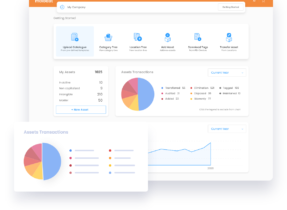Your Guide to Fixed Asset Depreciation
One of the crucial areas of Fixed Asset Management is understanding asset depreciation, as without a proper grip on this, you could be costing your company unnecessary money and affect its overall profit. In this piece, we’ll help you to get to know more about asset depreciation and how to monitor it. This is especially important if your business has a number of large investments. First, let’s determine what Fixed Assets relate to.
What Are Fixed Assets?
Almost every business has Fixed Assets and these are the biggest investment items. They include property and buildings (such as offices, stores, warehouses etc.), vehicles (trucks, vans, company cars, motorbikes etc.), computer equipment, software, printers, machinery, and anything else that is 'Fixed' and so not fluid (such as money, bonds, equities etc.).

Within any company that has large Fixed Assets, asset tracking and monitoring them is paramount as without understanding their status, where they’re located and who’s using them, you will undoubtedly end up with even bigger expenditure.
Most companies employ a Fixed Asset Manager to take care of anything to do with Fixed Assets, they may even have a team of people responsible for the area, especially if the business is in manufacturing – with factories full of expensive machinery. Fixed Asset Managers use Fixed Asset Software systems to track their assets, so they know where they are at any one time, who’s using them and what their depreciation is (amongst many other important aspects).
What is Fixed Asset Depreciation and Amortization?
Everything that we use depreciates over time and the same applies to Fixed Assets. It’s like driving a car away from the car dealership – the moment it’s signed over to you and you drive it off the forecourt, it starts depreciating in value. That’s because with every drive, and every turn of the key, the machinery begins to deteriorate. The same applies to Fixed Assets and over time, they too start to deteriorate, needing regular maintenance until they are retired and disposed of. This is why it is important to calculate your assets’ depreciation and record this information on your system so your company can calculate its financial statements.
Of course – depreciation of Fixed Assets is very important for companies as the process allows them to replace disposed assets once they’re ready to be retired. During the process, the financial department will reserve a percentage of the asset’s original value, as a provision. Then, this amount will be removed from the company’s profit. So, when a Fixed Asset is 100% depreciated, the business can retire it and to replace it with a new asset by utilizing the accumulated amount in the provision made. Amortization (the practice of spreading an intangible asset’s cost over the asset’s useful life) is handled similarly.
Here’s how to understand Fixed Asset Depreciation and work out what it is.
1. Identify Your Fixed Assets
First things first, every company should have an up-to-date list of all Fixed Assets (Fixed Asset Register) and record everything on high quality Fixed Asset software systems, such as Mojodat. The Mojodat Enterprise Asset Management system assigns assets’ barcoding using QR codes so that it’s easy to determine where a Fixed Asset is at any given time and to specify its status. In fact, it’s even easier to monitor Fixed Assets with an asset tracking system that uses an asset handheld application so you can track everything on the go. Items with a low value (less than the capitalization threshold) might not need to be included and neither might assets that are only short-term items. Different countries have different guidelines, but items like property usually have a depreciation of around 25 years, equipment, and furniture around 5 years. This exercise is part of asset lifecycle management so identify the major assets that you need to track.
2. What are Your Depreciation Factors?
Next, you need to think about the usual lifespan of the item in question. How often do you expect to use the item and for how long? Once it’s past its usable life, you can calculate a value of salvaging the item, if that’s possible. We’d recommend following international standards such as IFRS to determine the lifespan for each category.
3. Common Depreciation and Methods
There are several methods to work out depreciation, the best used are as follows:
• The Straight-line Method. Arguably, the most common and popular depreciation method. This method considers a fixed value or percentage, and the expected selling value during depreciation of the Fixed Asset.
• Units of Production Depreciation Method. This method depends on the Fixed Asset’s usage.
• Declining Balance Depreciation Method. This is accelerated depreciation of recording larger depreciation expenses during the earlier years of an asset’s useful life and recording smaller depreciation expenses during the asset’s later years.
• Sum of the Years’ Digits Method. This method helps in aligning the asset cost with its use each year across its useful life, it balances the depreciation expense with the other surplus charges such as maintenance and repairs.
4. Set Up Automation for Depreciation
A high-quality Fixed Assets’ Software system like Mojodat will help you to automate your depreciation as it applies formulae to each asset and works out the scrap value from the original cost, then divides that amount by an estimate of the asset’s overall lifespan. Of course, this will always be an estimate but it’s a fairly sound formula and will certainly give you a guideline to work from. Let’s use an example. Perhaps you want to calculate the depreciation value of your server? Maybe it cost $50k to install it in your business – the scrap value of the item is $10k and it should last 10 years. You minus the $10 from the $50k which gives you $40k. Take that number and divide it by the number of years (10) and you get $4k of depreciation annually. There are some other factors that affect lifespan such as appreciation, partial addition, and partial disposal.
5. Always Use a Fixed Asset Management Software Solution
This is really important as basic; Excel spreadsheets cannot cope with the amount of information required to ensure your online asset tracking is 100% spot on. You need a system that can upload multiple assets, use automated depreciation value, allow for easy asset counting and even provide asset GPS tracking. Mojodat can perform all of the above, and more including asset tracking using RFID.
Your asset database can also link to other databases in your company, such as accounting for seamless transition and easy-to-create balance sheets. Mojodat will create individual asset records, assign each with assets’ barcoding and even allow you to print barcode labels so all your assets are accounted for. Within this type of database, you store your depreciation estimates and compare it to the actual amount. You can easily see if your assets are declining too fast, or if they’re withholding their value. Plus, you’ll understand what assets need to be retired and disposed of and where more investment will need to be made to replace an asset when required.
6. Disposal of a Fixed Asset
Depreciating the fixed asset is a financial process while eliminating a Fixed Asset is mostly an operational process. So, it is very important to mention that depreciating a Fixed Asset does not necessarily mean disposing and retiring it. Most companies keep using the depreciated Fixed Asset if it is still in a good condition and if the maintenance cost of the asset is still less than the replacement cost.
Conclusion
Finally, understanding how to manage depreciation on Fixed Assets will help your business stay on track with its accounting. Using a reliable, reputable system will also provide seamless service and remove tedious, time-consuming tasks so your team can get on with other important tasks. Additionally, installing a Fixed Asset system will ensure that your business runs more efficiently, both financially and in manpower.
Subscribe to read the full article below.

